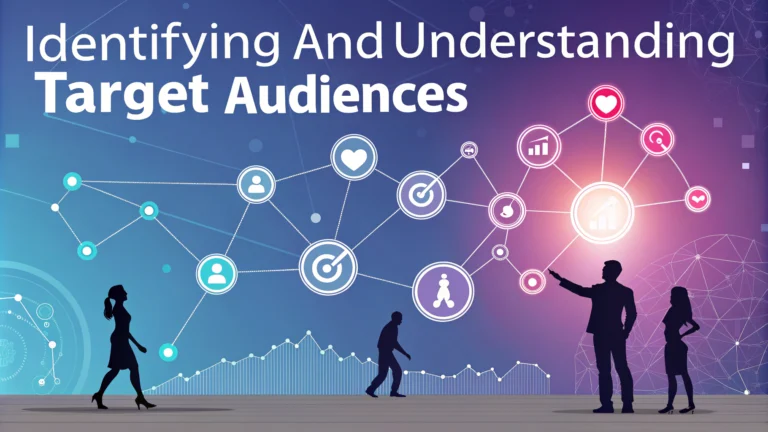Understanding your target audience stands as the foundation for creating effective logo designs that resonate and drive business success.
What Makes a Target Audience?
A target audience combines demographic factors like age, location, and income with psychographic elements including interests, values, and behaviors.
Key Demographics to Consider:
- Age range
- Gender distribution
- Geographic location
- Income level
- Education background
- Occupation
Psychographic Factors:
- Personal values
- Lifestyle choices
- Shopping habits
- Brand preferences
- Social media usage
Research Methods for Understanding Your Audience
Direct customer surveys, social media analytics, and competitor analysis provide valuable insights into your target audience’s preferences.
Effective Research Tools:
- Google Analytics – Track website visitor behavior
- SurveyMonkey – Create customer surveys
- Facebook Insights – Analyze social media engagement
- Google Trends – Track industry trends
Translating Audience Understanding into Logo Design
| Audience Type | Design Elements |
|---|---|
| Young, Tech-Savvy | Modern, minimal, bold colors |
| Professional Services | Classic, refined, muted tones |
| Family-Oriented | Friendly, rounded shapes, warm colors |
Testing Your Logo Design
Test your logo designs through A/B testing, focus groups, and social media polls to gather direct feedback from your target audience.
Testing Checklist:
- Color preference
- Font readability
- Emotional response
- Brand message clarity
- Size adaptability
Document audience feedback and make iterative improvements based on real data rather than assumptions.
Common Mistakes to Avoid
- Designing for personal preference instead of audience needs
- Ignoring cultural sensitivities
- Following trends without considering audience fit
- Skipping the research phase
Regular audience analysis and logo updates ensure your design remains relevant and effective for your target market.
Contact professional logo designers through platforms like Behance or Upwork for expert assistance in creating audience-focused logos.
Implementing Audience Feedback
Effective implementation of audience feedback requires systematic analysis and strategic adjustments to your logo design while maintaining brand consistency.
Feedback Implementation Process:
- Collect and categorize feedback
- Identify recurring themes
- Prioritize changes based on impact
- Create multiple iterations
- Validate adjustments with focus groups
Maintaining Brand Consistency
While adapting to audience preferences, maintain core brand elements that ensure recognition across different platforms and applications.
Brand Consistency Checklist:
- Color palette adherence
- Typography guidelines
- Spacing requirements
- Size variations
- Background compatibility
Measuring Logo Performance
| Metric | Measurement Method |
|---|---|
| Brand Recognition | Surveys and recall tests |
| Engagement | Social media interactions |
| Conversion Impact | A/B testing results |
Conclusion
Success in logo design hinges on thorough audience understanding, systematic testing, and continuous refinement based on measurable data. Regular evaluation and updates ensure your logo remains relevant and effective for your target audience while maintaining brand integrity.
Final Action Items:
- Schedule regular audience analysis
- Document design iterations
- Monitor performance metrics
- Plan periodic reviews
- Stay informed about audience trends
FAQs
- What exactly is a target audience in logo design?
A target audience in logo design refers to the specific group of people your logo aims to connect with and appeal to, based on demographics, psychographics, behaviors, and preferences that align with your brand’s ideal customers. - How do demographics influence logo design decisions?
Demographics like age, gender, income level, and location influence color choices, style, complexity, and overall aesthetics of your logo. For example, logos targeting younger audiences might use brighter colors and modern designs, while those targeting professionals might opt for more conservative approaches. - What research methods are effective for understanding target audiences?
Effective research methods include surveys, focus groups, competitor analysis, social media insights, customer interviews, market research data, and analyzing existing customer behavior patterns. - How does cultural background affect logo design for different target audiences?
Cultural background influences color interpretations, symbol meanings, and design preferences. For instance, white symbolizes death in some Asian cultures but purity in Western cultures, making it crucial to consider cultural context in logo design. - What role does psychographics play in logo design?
Psychographics examines lifestyle, values, attitudes, and interests of target audiences, helping designers choose appropriate visual elements that resonate with the audience’s personality and preferences. - How can I ensure my logo appeals to multiple target audiences?
Create a versatile design that maintains core brand elements while allowing for subtle variations in color, arrangement, or presentation to appeal to different segments while maintaining brand consistency. - What are the key indicators that a logo is not connecting with its target audience?
Key indicators include low brand recognition, negative feedback, lack of engagement, confused audience response, and poor performance compared to competitors in the same market segment. - How often should target audience analysis be updated for logo design?
Target audience analysis should be reviewed annually or when significant market changes occur, such as entering new markets, shifts in customer demographics, or major societal changes affecting consumer behavior. - What tools can help in analyzing target audiences for logo design?
Tools include Google Analytics, social media analytics, customer relationship management (CRM) systems, survey platforms like SurveyMonkey, and market research databases. - How do B2B and B2C target audiences differ in logo design preferences?
B2B logos typically favor professional, conservative designs emphasizing stability and expertise, while B2C logos often employ more creative, emotional, and trend-conscious approaches to connect with individual consumers.







